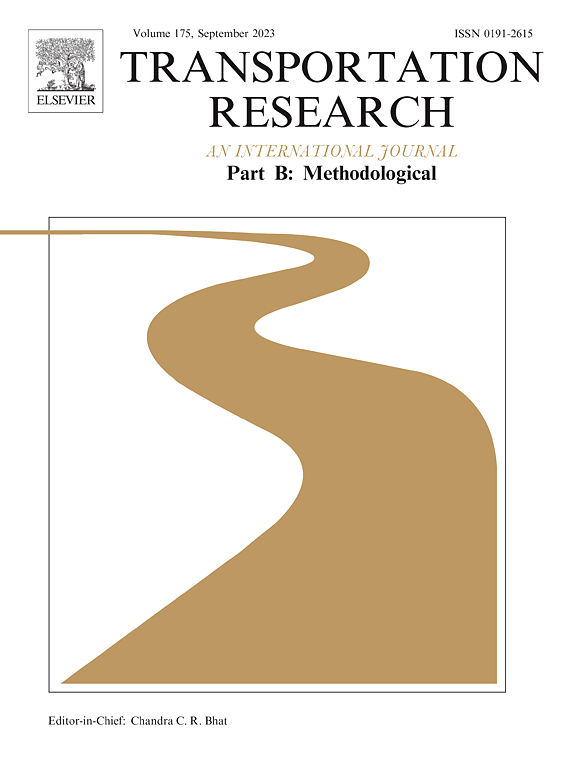Solving connected automated vehicle merging problems: A generalized benders decomposition-based approach for mixed-integer nonlinear programming
IF 6.3
1区 工程技术
Q1 ECONOMICS
引用次数: 0
Abstract
Intensive interactions among vehicles often lead to congestion and accidents, particularly at freeway merging sections. As connected automated vehicles (CAVs) become a reality, their collaborative driving offers a promising solution. However, the real-time scheduling and trajectory planning for multiple CAV streams remain challenging and are not adequately addressed in the existing literature. To this end, this study formulates an integrated mixed-integer nonlinear programming (MINLP) model to jointly optimize lane change decisions, vehicle sequences, and vehicle trajectories, with the objective of maximizing traffic efficiency and driving comfort at multi-lane freeway merging sections. Existing commercial software struggles to handle such a complicated model. To rapidly obtain solutions, this study designs a Generalized Benders Decomposition (GBD)-based solution algorithm to tackle the problem of multi-vehicle combinatorial optimization and nonlinear trajectory optimization. Meanwhile, the finite convergence property of the GBD approach is proved. Numerical experimental results demonstrate that the proposed model outperforms three benchmark CAV control methods and a two-step method under various traffic demands and mainline-ramp demand ratios, highlighting significant traffic benefits from jointly planning lane changes and driving sequences, as well as utilizing microscopic vehicle information. Furthermore, this study evaluates traffic delay and the number of lane changes under varying road lengths, i.e., the lengths of lane-changing and merging areas, identifying recommended lengths for the maximum traffic efficiency, and analyzing the performance trend under varying traffic demands.
求解网联自动车辆归并问题:基于广义弯曲分解的混合整数非线性规划方法
车辆之间的密集互动经常导致拥堵和事故,特别是在高速公路合流路段。随着互联自动驾驶汽车(cav)成为现实,它们的协同驾驶提供了一个很有前景的解决方案。然而,多CAV流的实时调度和轨迹规划仍然具有挑战性,并且在现有文献中没有得到充分的解决。为此,本文建立了一种综合混合整数非线性规划(MINLP)模型,以多车道高速公路合流路段的交通效率和驾驶舒适性最大化为目标,对变道决策、车辆序列和车辆轨迹进行联合优化。现有的商业软件难以处理如此复杂的模型。为了快速求解,本文设计了一种基于广义弯曲分解(GBD)的求解算法来解决多车组合优化和非线性轨迹优化问题。同时,证明了GBD方法的有限收敛性。数值实验结果表明,该模型在不同交通需求和主干道匝道需求比下优于三种基准CAV控制方法和两步控制方法,突出了联合规划变道和行驶顺序以及利用微观车辆信息的显著交通效益。在此基础上,对不同道路长度(即变道区和并合区长度)下的交通延迟和变道次数进行评价,确定最大交通效率的推荐长度,并分析不同交通需求下的性能趋势。
本文章由计算机程序翻译,如有差异,请以英文原文为准。
求助全文
约1分钟内获得全文
求助全文
来源期刊
CiteScore
12.40
自引率
8.80%
发文量
143
审稿时长
14.1 weeks
期刊介绍:
Transportation Research: Part B publishes papers on all methodological aspects of the subject, particularly those that require mathematical analysis. The general theme of the journal is the development and solution of problems that are adequately motivated to deal with important aspects of the design and/or analysis of transportation systems. Areas covered include: traffic flow; design and analysis of transportation networks; control and scheduling; optimization; queuing theory; logistics; supply chains; development and application of statistical, econometric and mathematical models to address transportation problems; cost models; pricing and/or investment; traveler or shipper behavior; cost-benefit methodologies.

 求助内容:
求助内容: 应助结果提醒方式:
应助结果提醒方式:


